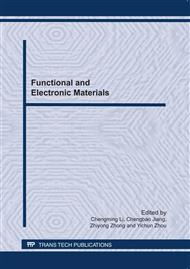p.505
p.510
p.519
p.523
p.528
p.533
p.539
p.548
p.552
The Effect of Vacancy on the Phase Stability of TiNi Shape Memory Alloy from First-Principle Calculation
Abstract:
The effect of vacancy on the phase stability of TiNi shape memory alloy has been investigated by the first-principle method based on the density functional theory with generalized gradient approximation. The formation energy, formation heat, formation enthalpy per atom and density of states (DOS) of TiNi alloy with and without vacancy are calculated. The results indicate that the favorable point defect is Ni vacancy in both B2 and B19’ phases of TiNi alloy. The existence of vacancy increases the formation enthalpies per atom difference and thus decreases the phase stability. The DOS values at Fermi level of martensitic phases are lower than that of austenite phases in both perfect TiNi and TiNi with Ni vacancy, indicating the natural transformation from austenite to martensite upon cooling.
Info:
Periodical:
Pages:
528-532
Citation:
Online since:
June 2011
Price:
Сopyright:
© 2011 Trans Tech Publications Ltd. All Rights Reserved
Share:
Citation:


